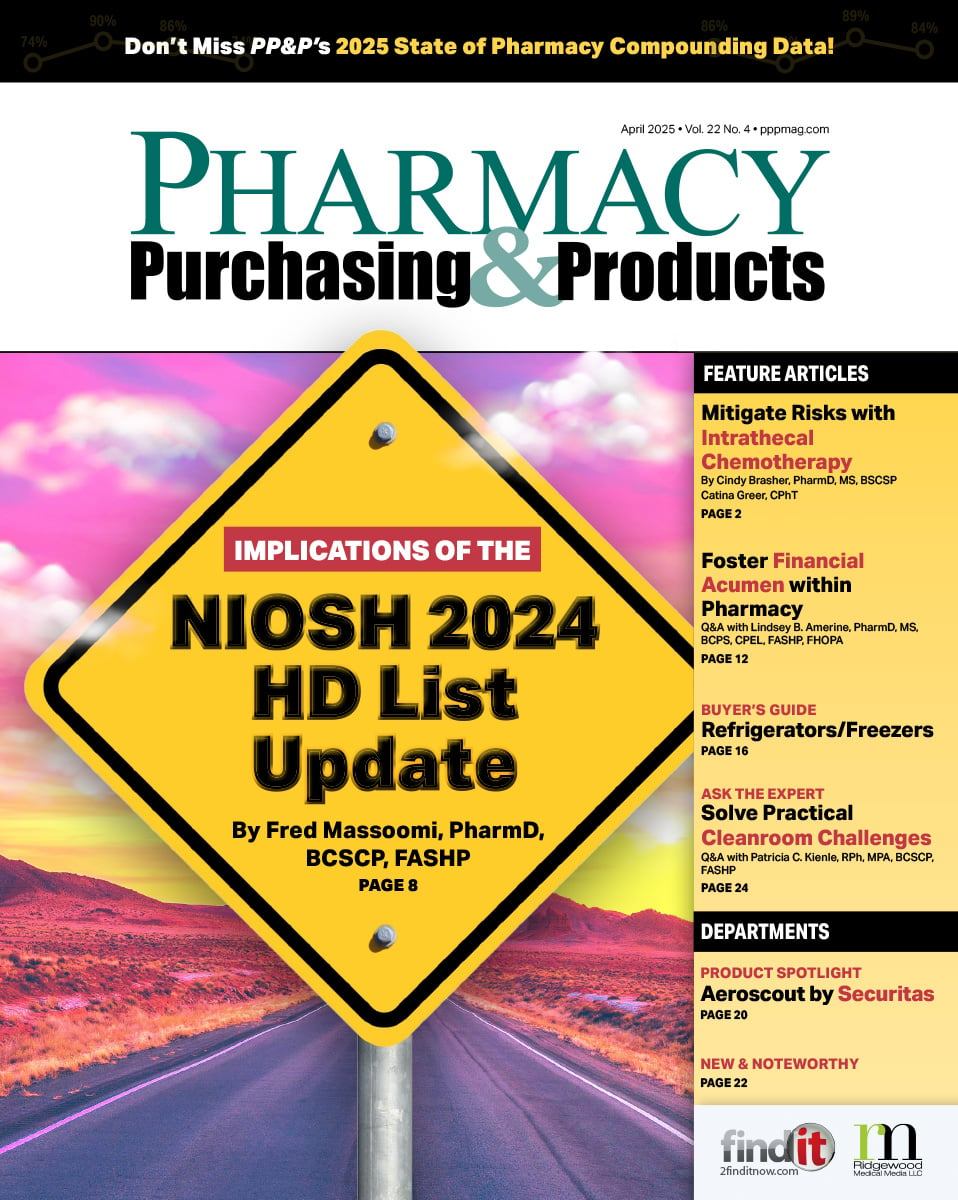- Show Menu
- Contact Us
- FAQs
- Reader Service
- Survey Data
- Survey Winners
- Testimonials
- Upcoming Events
- Webinars
- White Papers
Safe Parenteral Nutrition Prescribing and Order Review
Parenteral nutrition (PN), a complex prescription therapy, is designated a high-alert medication by the Institute for Safe Medication Practices (ISMP).1 Despite this classification, a recent PN use survey with gap analysis reported that only 56% of organizations have precautions in place to prevent errors and patient harm associated with PN.2 The American Society for Parenteral and Enteral Nutrition’s (ASPEN) Parenteral Nutrition Safety Consensus Recommendations address safety concerns throughout the PN process, including prescribing, order review and verification, compounding, and administration of PN.3 Compliance with the ASPEN recommendations is critical to prevent PN errors and avert the potential for patient harm throughout the PN process; thus, organizations must ensure they fully understand and implement the recommendations.
This is the first part of a two-part article series: Part 1 addresses potential errors that may occur during PN prescribing, order review, and verification; Part 2, which will be published in a future issue of Pharmacy Purchasing & Products, will address potential errors in the compounding and administration phases of the PN process.
Case Examples of PN Errors
PN order entry errors have caused significant patient harm, including death. ISMP reports an order entry error of a PN prescription for a 16-year-old boy, weighing 72 kg, by a physician using a pediatric PN template in an electronic health record (EHR) intended for patients weighing 40 kg or fewer.4 This template prompted prescribers to order most ingredients in measurement of units of g/kg, mEq/kg, or mmol/kg, using the patient’s weight in the EHR. The prescriber ordered the PN nutrients as gram or mEq per kg in a total volume of 2640 mL to infuse over 24 hours.
The pharmacy pediatric PN template was organized using dose of ingredients per kg for patients weighing 40 kg or fewer, but if the patient weighed more than 40 kg, the PN template required entry of all nutrients in measurement unit of g/day, mEq/day, or mmol/day; therefore, the transcription pharmacist had to transcribe from the pediatric template and manually change the prescribed per kg doses to the corresponding total daily amounts. The pharmacist who entered the PN order was still in training and entered the order into the template for pediatric patients weighing more than 40 kg, but did not manually change the prescribed per kg doses to the corresponding total daily amounts. The incorrect formula was subsequently prepared using an automated compounding device. After the PN was mixed, another pharmacist checked the final preparation but failed to notice the incorrect units of measure and very low total amounts of nutrients listed on the label.
The patient’s nurse also checked the PN label with the prescriber’s order, but did not notice the errors. Consequently, the patient received almost the entire bag of PN before the error was discovered the next day. After the correct PN solution was started, the incorrect PN solution was sent for analysis and was found to be extremely hypotonic at 138 mOsm/L. Fortunately, the patient did not experience any adverse effects.
Fatal errors involving PN have been reported by ISMP as well. One report involved a sodium dose of 14.7 mEq confused with a 982 mg dose of calcium. The prescribed dose of calcium was entered into the sodium field as 982 mEq of sodium. The infant who received the PN experienced a cardiac arrest and died.5 In another case, an infant died from a 1000-fold overdose of zinc; the pharmacist entering the order accidentally chose mg instead of mcg.5 Other common PN errors are listed in the TABLE.
These examples highlight the importance of pharmacist review and verification of PN orders, yet review alone may not be sufficient to ensure patient safety. Health care organizations should take advantage of the opportunity to enhance the safety of PN by standardizing the review and verification processes.

ASPEN Consensus Recommendations: Prescribing
The ASPEN Consensus Recommendations provide guidance to reduce PN prescribing and communication errors.3 General recommendations are listed below; nevertheless, it is imperative that pharmacists review the actual recommendations in their entirety for an in-depth understanding of the issues surrounding PN safety.
Standardization
Standardized order formats for PN that incorporate prescriber guidelines can reduce prescribing errors, improve efficiency and productivity, and ultimately minimize waste and costs.2,3 To undertake this endeavor, develop a standardized process for PN management that encompasses written policies and procedures (P&Ps) as well as a comprehensive education program. The P&P serves as a tool to ensure that these safe procedures are always incorporated into practice. Clearly document the patient’s medical problem(s), PN indication(s), and appropriate intravenous access. Specify and document the therapeutic goals for PN. Prescribers should use a standardized, electronic PN order template with clinical decision support. Use a CPOE system that is fully integrated with an automated compounding device; avoid handwritten, verbal, and telephone orders, except for pharmacists communicating a modification or clarification to a prescriber. Any transcribed data should receive an independent double-check.
In addition, ensure that PN for adults is ordered in amounts per day and ordered in amounts per kg per day for neonate and pediatric patients. Do not allow PN electrolytes to be ordered as ions, but rather as complete salts. Institutions should create a home PN order template to provide a safe plan for multiple days of therapy. Likewise, create a policy to dictate the duration of a PN order. Finally, when reordering, ensure that PN is ordered in its entirety.
ASPEN Consensus Recommendations: Order Review and Verification
PN formulations may contain more than 40 ingredients, including amino acids, dextrose, lipid injectable emulsions, electrolytes, vitamins, trace elements, insulin, and other medications.3 Due to the complexity of these formulations, pharmacist order review and verification is critical. The 2014 ASPEN consensus recommendations provide important considerations for ensuring safety throughout the PN order review and verification process.3 A synopsis of these recommendations is listed below; see the full text for additional details.
Develop written P&Ps for order review and verification. P&Ps and/or protocols should be in place to clarify PN orders when doses are out of range or potential incompatibilities may exist. P&Ps should also be in place for standardized PN labeling.
PN orders should undergo a clinical review to assess appropriateness and safety. The following elements should be reviewed with each PN order:
- Proper indication consistent with published guidelines
- Osmolarity is appropriate for route of administration
- Macronutrient, micronutrient, and non-nutrient medication is clinically appropriate
- New formulation prescription compared to previous day’s prescription
- Use up-to-date laboratory data for significant changes that could impact the PN
- Compatibility and stability for admixture
PN order review and verification should be done in an environment free from distractions. Pharmacists assessing PN orders should demonstrate competency in regards to PN, and those involved with the PN process should have specialty residency training or board certification in nutrition support. Health care organizations should develop criteria for order review and verification of staff competencies.3
The Impact of Automated PN Ordering and Compounding
Introducing automation to the PN process, including computerized prescriber order entry (CPOE) and automated compounding devices, can improve PN safety. One study compared the frequency and severity of PN medication errors at a children’s hospital after implementing electronic ordering and automated compounding, in compliance with the ASPEN PN guidelines.6 The PN error rate, tracked for 7 years after CPOE implementation, was 0.27% (or 2.7 errors per 1000 PN prescriptions), which is significantly lower than national data that determined that 1.6% of PN prescriptions are associated with a medication error. To prevent the potential for PN errors, organizations should strongly consider automating the PN ordering process.
Conclusion
PN is a complex medication that ISMP denotes as high-risk with the potential to cause harm. To ensure safety, P&Ps that cover all phases of the PN process must be in place. A standardized process that utilizes computerized ordering with clinical decision support at the point of prescribing should be the goal of health care organizations involved in the delivery of PN.
References
- Institute for Safe Medication Practices. ISMP’s List of High-Alert Medications in Acute Care Settings (2014). www.ismp.org/tools/highalertmedications.pdf. Accessed May 4, 2017.
- Boullata JI, Guenter P, Mirtallo JM. A parenteral nutrition use survey with gap analysis. JPEN J Parenter Enteral Nutr. 2013;37(2):212-222.
- Ayers P, Adams S, Boullata J, et al. A.S.P.E.N. parenteral nutrition safety consensus recommendations. JPEN J Parenter Enteral Nutr. 2014;38(3):296-333.
- Institute for Safe Medication Practices. Mismatched Prescribing and Pharmacy Templates for Parenteral Nutrition (PN) Lead to Data Entry Errors (2012). www.ismp.org/newsletters/acutecare/showarticle.aspx?id=25. Accessed May 4, 2017.
- Institute for Safe Medication Practices. ISMP Medication Safety Alert! (April 21, 2011.) Another Tragic Parenteral Nutrition Compounding Error. www.ismp.org/newsletters/acutecare/articles/20110421.asp. Accessed May 4, 2017.
- Mackay M, Anderson C, Boehme S, et al. Frequency and severity of parenteral nutrition medication errors at a large children’s hospital after implementation of electronic ordering and compounding. Nutr Clin Pract. 2016;31(2):195-206.
- Storey MA, Weber RJ, Besco K, et al. Evaluation of parenteral nutrition errors in an era of drug shortages. Nutr Clin Pract. 2016;31(2):211-217.

Phil Ayers, PharmD, BCNSP, FASHP, is a clinical specialist in nutrition support and chief of clinical pharmacy services in the department of pharmacy at Baptist Health Systems in Jackson, Mississippi. He serves as secretary-treasurer for the board of directors of ASPEN, and is the current president of the Mississippi Pharmacists Association. Phil received his BS in pharmacy and his PharmD from the University of Mississippi.

Jenny Anderson, MS, RD, LD, CNSC, is a registered dietitian at Baptist Health Systems in Jackson, Mississippi. She completed her undergraduate degree in nutrition and dietetics at the University of Southern Mississippi and obtained her Masters Degree from the University of Alabama.

Carman Dixon, PharmD, is a clinical pharmacy specialist at Mississippi Baptist Medical Center in Jackson, Mississippi. He received his PharmD from the University of Mississippi. Carman is the lead pharmacist for the pharmacokinetics service in addition to serving on the medication safety and pharmacy and therapeutics committees. He is a past-president of the Mississippi Society of Health-System Pharmacists and is the current education chairman for the Mississippi Pharmacists Association.

Andrew Mays, PharmD, CNSC, is a clinical pharmacy specialist in nutrition support at the University of Mississippi Medical Center in Jackson, Mississippi and is a clinical assistant professor at the University of Mississippi School of Pharmacy. He serves as president-elect for the Mississippi Society of Health-System Pharmacists and president of the Mississippi Society for Parenteral and Enteral Nutrition. Andrew received his PharmD from the University of Mississippi.
Like what you've read? Please log in or create a free account to enjoy more of what www.pppmag.com has to offer.








